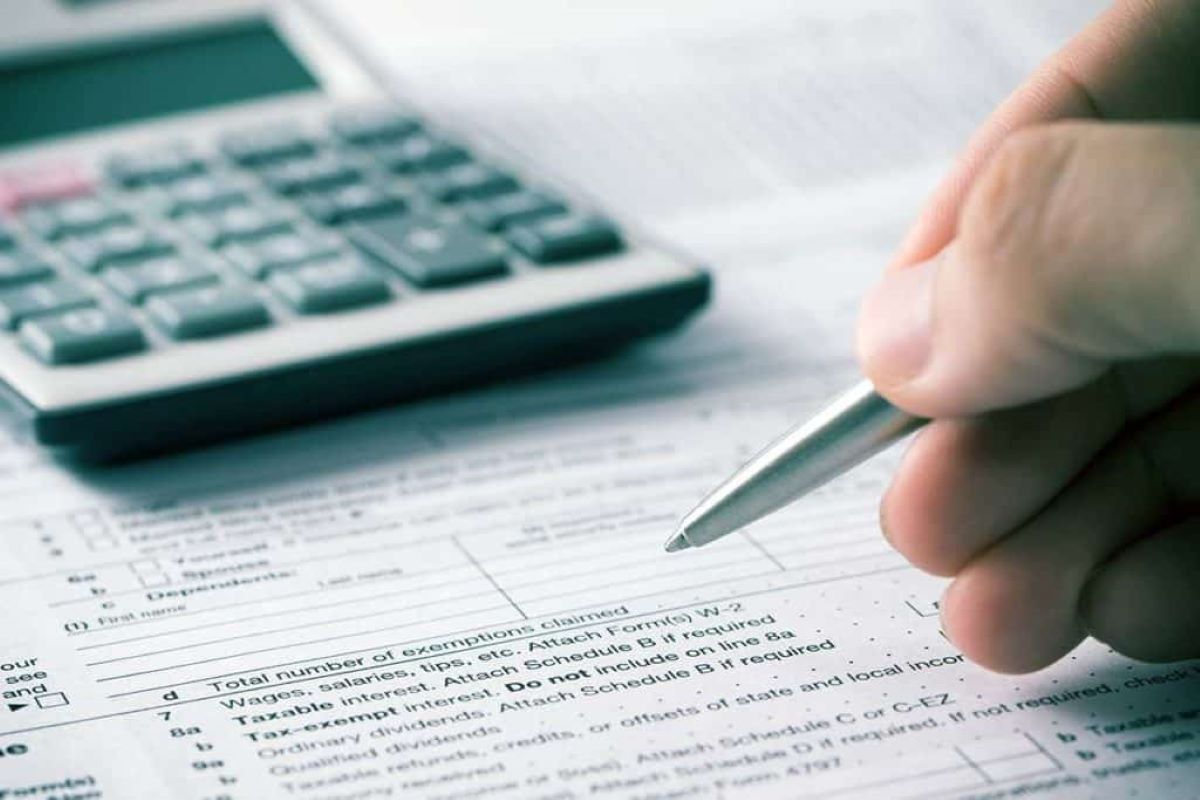Home>Finance>How Do Depreciation Rules Enter Into Tax Planning?


Finance
How Do Depreciation Rules Enter Into Tax Planning?
Published: January 20, 2024
Learn how depreciation rules can impact tax planning in the field of finance, and how to navigate them effectively to optimize your financial strategy.
(Many of the links in this article redirect to a specific reviewed product. Your purchase of these products through affiliate links helps to generate commission for LiveWell, at no extra cost. Learn more)
Table of Contents
- Introduction
- Understanding Depreciation
- Tax Planning and Depreciation
- Types of Depreciation Methods
- Depreciation Rules and Regulations
- Factors to Consider in Tax Planning
- Maximizing Depreciation Deductions
- The Importance of Accurate Record-Keeping
- Depreciation Recapture Rules
- Strategies for Optimizing Tax Planning with Depreciation
- Conclusion
Introduction
When it comes to managing your finances, tax planning plays a crucial role in minimizing your tax liability and maximizing your financial benefits. One essential aspect of tax planning is understanding and utilizing depreciation rules. Depreciation allows individuals and businesses to deduct the cost of assets over time, reflecting the wear and tear or obsolescence of these assets.
Depreciation is a complex and important concept for anyone involved in tax planning. It not only affects your current tax liability but can also have significant implications for future tax obligations. By understanding the rules and regulations surrounding depreciation, you can make informed decisions and implement strategies to optimize your tax planning.
In this article, we will delve into the realm of depreciation, explore the relationship between depreciation and tax planning, and provide insights into various depreciation methods and rules. We will also discuss factors to consider in tax planning, ways to maximize depreciation deductions, the importance of accurate record-keeping, and strategies for optimizing tax planning with depreciation.
By the end of this article, you will have a clear understanding of how depreciation rules enter into tax planning and acquire practical knowledge to apply these insights to your personal or business financial situation.
Understanding Depreciation
Depreciation is the process of allocating the cost of an asset over its useful life. It recognizes that assets, such as buildings, machinery, vehicles, and equipment, deteriorate or become less valuable over time due to wear and tear, technological advancements, or market changes.
By spreading out the cost of an asset over its useful life, depreciation allows businesses and individuals to match the expense of acquiring the asset with the revenue it generates. This not only provides a more accurate representation of their financial performance but also allows for tax benefits through deductions.
Depreciation is typically calculated using three main factors: the cost of the asset, the estimated useful life of the asset, and the asset’s salvage value (its value at the end of its useful life). Different depreciation methods exist, each with its own rules and formulas to determine the annual depreciation expense.
Understanding depreciation is essential for effective tax planning. It enables you to determine how depreciation affects your taxable income, deductions, and overall tax liability. By properly depreciating assets, you can reduce your taxable income, lower your tax liability, and potentially increase cash flow.
It’s important to note that depreciation rules may vary depending on the jurisdiction and the type of asset. Specific guidelines and regulations govern the depreciation of assets for tax purposes, and it’s crucial to stay up-to-date with any changes or updates to the tax laws.
Now that we have a basic understanding of depreciation, let’s explore how depreciation rules come into play in tax planning and how they can benefit individuals and businesses.
Tax Planning and Depreciation
Depreciation plays a significant role in tax planning as it allows individuals and businesses to reduce their taxable income and lower their overall tax liability. By strategically allocating depreciation expenses, you can maximize deductions and potentially save a substantial amount of money.
When it comes to tax planning, timing is crucial. Depreciation allows you to control the timing of your deductions by determining when and how much of the asset’s cost you allocate as an expense. By accelerating or delaying depreciation deductions, you can manipulate your taxable income in a given year to minimize your tax burden.
For example, if you expect higher income in the current year but anticipate lower income in future years, it may be advantageous to accelerate depreciation deductions to offset the higher income and reduce your tax liability for the current year. On the other hand, if you anticipate higher income in future years, you may choose to delay depreciation deductions to take advantage of the deductions when they will have a greater impact on reducing your taxable income.
Tax planning also involves choosing the most appropriate depreciation method for your assets. Different methods, such as straight-line depreciation, accelerated depreciation, or the Modified Accelerated Cost Recovery System (MACRS), provide varying depreciation schedules and rates. By carefully selecting the depreciation method that aligns with your financial goals and circumstances, you can optimize your tax savings.
Furthermore, tax planning with depreciation extends beyond simply deducting the cost of the asset. It also involves considering depreciation recapture rules. Depreciation recapture occurs when you sell or dispose of an asset for more than its depreciated value. In such cases, you may be required to include a portion of the gain as taxable income, potentially offsetting some of the tax benefits gained through depreciation.
Proper tax planning with depreciation requires a thorough understanding of the various depreciation methods, their tax implications, and the specific rules and regulations governing depreciation in your jurisdiction. Working with a tax professional or financial advisor experienced in tax planning can provide valuable guidance to help you make informed decisions and optimize your tax savings.
Now that we have explored the relationship between tax planning and depreciation, let’s delve deeper into the different depreciation methods and how they affect tax planning.
Types of Depreciation Methods
There are several different methods used to calculate and allocate depreciation expenses over an asset’s useful life. Each method has its own set of rules and formulas, which determine how depreciation is calculated and deducted for tax purposes. Understanding the different depreciation methods is crucial for effective tax planning. Let’s explore some of the most commonly used methods:
- Straight-Line Depreciation: This is the simplest and most commonly used depreciation method. It allocates the same amount of depreciation expense evenly over the asset’s useful life. The formula for straight-line depreciation is: (Cost of Asset – Salvage Value) / Useful Life. This method is straightforward to calculate and provides equal deductions each year.
- Accelerated Depreciation: This method allows for higher depreciation deductions in the early years of an asset’s life, followed by lower deductions in later years. It recognizes that assets tend to lose value more rapidly in the earlier years. Accelerated depreciation methods include the double declining balance method and the sum-of-the-years’ digits method. These methods allow businesses to deduct a larger portion of the asset’s cost upfront, resulting in greater tax savings in the earlier years.
- Modified Accelerated Cost Recovery System (MACRS): MACRS is a depreciation method used for tax purposes in the United States. It provides specific depreciation schedules based on asset classes and recovery periods defined by the Internal Revenue Service (IRS). MACRS allows for accelerated depreciation deductions, with different percentages and methods for different asset types, such as residential rental property, nonresidential real property, and machinery.
- Unit of Production Depreciation: This method takes into account the asset’s usage or production level to calculate depreciation. It assigns a specific depreciation expense to each unit of output or usage. Assets that are closely tied to production or usage, such as vehicles, manufacturing equipment, or agricultural machinery, often use this method. The formula for unit of production depreciation is: (Cost of Asset – Salvage Value) / Total Units of Production.
- Group Depreciation: Group depreciation allows businesses to combine similar assets into a single pool for depreciation purposes. This method simplifies the calculation and administration of depreciation for a group of assets with similar characteristics. Instead of depreciating each asset individually, the total cost of the assets is pooled, and a depreciation rate is applied to the group as a whole.
It’s important to note that the choice of depreciation method can significantly impact your tax planning strategy. The method you select should align with your financial goals, the nature of your assets, and the applicable tax laws. Working with a tax professional can provide valuable guidance in determining the most suitable depreciation method for your specific circumstances.
Now that we have discussed the different depreciation methods, let’s explore the rules and regulations surrounding depreciation to ensure accurate and compliant tax planning.
Depreciation Rules and Regulations
Depreciation rules and regulations outline the requirements and guidelines for calculating and claiming depreciation deductions for tax purposes. These rules ensure consistency and accuracy in depreciating assets and help maintain fairness in the tax system. Understanding these rules is essential for proper tax planning and compliance. Let’s explore some important aspects of depreciation rules and regulations:
IRS Guidelines: In the United States, the Internal Revenue Service (IRS) provides guidelines and regulations for depreciating assets for federal income tax purposes. These guidelines specify the depreciation methods, recovery periods, and allowable deductions for different asset types.
Asset Classification: Assets are classified into different categories with specific recovery periods assigned to each category. For example, residential rental property typically has a recovery period of 27.5 years, while nonresidential real property may have a recovery period of 39 years. Different recovery periods determine the length of time over which an asset’s cost can be depreciated.
Depreciation Deduction Limits: Some assets have specific depreciation deduction limits imposed by tax laws. For example, passenger vehicles used for business purposes are subject to annual depreciation deduction limits to prevent excessive deductions. These limits may change from year to year, so staying abreast of current regulations is crucial.
Placed-in-Service Date: The IRS requires assets to be placed in service before they can be depreciated. The placed-in-service date is the date when an asset is ready and available for its intended use. It marks the beginning of the asset’s recovery period and determines when depreciation deductions can be claimed.
Mid-Quarter Convention: The mid-quarter convention may apply if the total cost of all assets placed in service in the last quarter of the tax year exceeds 40% of the total cost of all assets placed in service during the entire year. Under this convention, a greater portion of depreciation deductions is allocated to the middle of the year to avoid potential abuse of tax planning strategies.
Change in Useful Life or Recovery Period: If there are changes in the useful life or recovery period of an asset, adjustments may need to be made to the depreciation calculations. These adjustments ensure that depreciation deductions accurately reflect the asset’s revised expected life and comply with the IRS guidelines.
It’s important to note that depreciation rules and regulations can be complex and may vary depending on the jurisdiction and applicable tax laws. Tax professionals or financial advisors with expertise in tax planning can provide valuable assistance in navigating the intricacies of depreciation rules and ensuring compliance.
Now that we have covered the rules and regulations surrounding depreciation, let’s move on to exploring the factors to consider in tax planning when it comes to depreciation.
Factors to Consider in Tax Planning
When it comes to tax planning with depreciation, several factors should be taken into consideration to optimize your tax savings and ensure compliance with applicable tax laws. These factors will help you make informed decisions and implement effective tax planning strategies. Let’s explore some of the key factors to consider:
Asset Classification: The classification of assets is crucial in determining the appropriate depreciation method, recovery period, and allowable deductions. Different assets may have different depreciation rules and guidelines, so understanding the classification of your assets is vital for accurate tax planning.
Tax Laws and Regulations: Tax laws and regulations are constantly evolving. It’s important to stay up-to-date with any changes or updates to tax laws that may impact your tax planning strategies. Working with a tax professional or staying informed through reliable sources will ensure that you are aware of any new regulations or deductions that could benefit your tax planning efforts.
Timing and Income Levels: Consider your current and future income levels when planning your depreciation deductions. If you anticipate higher income in the future, it may be beneficial to delay depreciation deductions to offset that income. Conversely, if you have higher income now, accelerating depreciation deductions can help reduce your current tax liability.
Cash Flow Needs: Depreciation affects your cash flow since it reduces your taxable income. Assess your cash flow needs and determine whether accelerating or delaying depreciation deductions aligns with your financial goals and liquidity requirements.
Long-Term Goals: Consider your long-term financial goals when planning depreciation and tax strategies. If you plan to sell or dispose of assets in the future, understanding the depreciation recapture rules and potential tax implications will help you make decisions that align with your objectives.
Future Investment Plans: If you anticipate making additional investments or purchases in the future, factor in how those assets will be depreciated and plan your depreciation schedules accordingly. Coordinating your depreciation strategies with future investments can help optimize your tax planning and maximize deductions.
Record-Keeping and Documentation: Accurate record-keeping is essential for maintaining compliance with depreciation rules and regulations. Keep detailed records of asset acquisition costs, placed-in-service dates, salvage values, and any other relevant information to support your depreciation deductions. Good record-keeping ensures that you can substantiate your deductions in case of an audit or review from tax authorities.
By considering these factors and working with a tax professional or financial advisor, you can develop a comprehensive tax planning strategy that leverages depreciation deductions to minimize your tax liability while aligning with your financial goals and compliance requirements.
Now that we have explored the factors to consider in tax planning, let’s move on to discussing strategies for maximizing depreciation deductions to further enhance your tax planning efforts.
Maximizing Depreciation Deductions
Maximizing depreciation deductions is a key aspect of effective tax planning. By strategically leveraging depreciation, you can lower your taxable income and potentially increase your tax savings. Here are some strategies to consider when aiming to maximize your depreciation deductions:
- Accelerate Depreciation: If your goal is to reduce your current tax liability, consider accelerating depreciation deductions. This can be done by choosing depreciation methods that front-load deductions, such as accelerated depreciation methods like the double declining balance or MACRS methods with shorter recovery periods.
- Section 179 Deduction: Take advantage of the Section 179 deduction, which allows businesses to deduct the full cost of qualifying assets in the year of purchase, instead of depreciating them over time. This deduction is limited to a certain dollar amount each year, so consider utilizing it for eligible assets that provide significant tax benefits.
- Bonus Depreciation: Utilize bonus depreciation, an additional deduction that allows businesses to deduct a percentage (often 100%) of the cost of qualifying assets in the year of purchase. Bonus depreciation can provide a significant immediate deduction and is an important tool for maximizing depreciation deductions.
- Disposal of Unneeded Assets: Consider disposing of assets that are no longer needed or have become obsolete. By doing so, you can take advantage of depreciation recapture rules and potentially offset some of the tax benefits gained from the depreciation deductions claimed on those assets.
- Consider Cost Segregation: For commercial properties, consider undertaking a cost segregation study. This study identifies components of a property that can be depreciated over shorter recovery periods, resulting in higher depreciation deductions in the early years of ownership.
- Keep Accurate and Detailed Records: Accurate record-keeping is crucial for substantiating your depreciation deductions. Maintain detailed records of asset purchase costs, placed-in-service dates, and any relevant supporting documentation. This will help ensure compliance and provide evidence in case of audits or reviews.
- Work with a Tax Professional: Tax laws and regulations surrounding depreciation can be complex. Consulting with a tax professional or financial advisor experienced in tax planning can provide valuable insights and guidance to help you navigate the intricacies and make informed decisions.
It’s important to note that while maximizing depreciation deductions can provide significant tax benefits, it should be done within the boundaries of tax regulations and with a focus on your long-term financial goals. Consult with a professional to ensure your strategies align with applicable tax laws and optimize your tax planning efforts.
Now that we have explored strategies for maximizing depreciation deductions, let’s move on to discussing the importance of accurate record-keeping when it comes to depreciation.
The Importance of Accurate Record-Keeping
Accurate record-keeping is essential when it comes to depreciation and tax planning. Keeping detailed and organized records of your assets and associated costs is crucial for substantiating your depreciation deductions and maintaining compliance with tax laws. Here are some reasons why accurate record-keeping is important:
Substantiating Depreciation Deductions: Accurate records serve as evidence to support your claimed depreciation deductions. Tax authorities may request documentation to verify the cost of assets, placed-in-service dates, and other relevant details. Having thorough records readily available ensures that you can provide the necessary information and substantiate your deductions, reducing the risk of audits or disputes.
Maintaining Compliance: Tax laws and regulations require taxpayers to accurately depreciate assets and comply with specific guidelines. By keeping accurate records, you can ensure that your depreciation calculations align with the applicable rules and that you are meeting the requirements set by tax authorities. This helps avoid potential penalties or consequences associated with non-compliance.
Supporting Asset Valuations: Accurate records of asset costs and improvements can help with valuations in situations such as insurance claims, property appraisals, or potential sales. Having detailed documentation can provide a clear picture of the value of your assets, which is essential for making informed financial decisions and accurately reporting your asset values for various purposes.
Facilitating Asset Management: Accurate record-keeping helps in effectively managing your assets. By keeping track of the acquisition dates, costs, and useful lives of your assets, you can strategically plan for replacements, upgrades, or disposals. This ensures that your depreciation calculations remain accurate and that you are maximizing the value of your assets.
Audit Preparedness: In the event of an audit or review by tax authorities, accurate records can save you time, stress, and potentially expensive penalties. By having well-organized documentation readily available, you can respond to inquiries and provide the necessary evidence to support your depreciation deductions. This demonstrates your adherence to tax laws and helps resolve any issues efficiently.
Continuity and Succession Planning: Accurate records play a crucial role in continuity and succession planning. When transferring assets or a business to another party, accurate and detailed records provide transparency and confidence in the valuation and transfer process. This allows for smoother transitions and ensures the accuracy of financial statements and tax reporting.
Accurate record-keeping is an ongoing process that requires attention to detail and organization. Utilize tools and systems to effectively manage your records, including asset acquisition documents, invoices, receipts, and any other relevant documentation. Regularly review and update your records to reflect any changes to your assets’ status, improvements, or disposals.
In summary, accurate record-keeping is crucial for substantiating depreciation deductions, maintaining compliance with tax laws, supporting asset valuations, and facilitating effective asset management. By prioritizing accurate record-keeping, you can optimize your tax planning efforts and mitigate potential risks associated with non-compliance or inaccurate reporting.
Now, let’s explore the depreciation recapture rules and their significance in tax planning.
Depreciation Recapture Rules
Depreciation recapture rules are an important aspect of tax planning when it comes to disposing of assets that have been depreciated. These rules determine how much of the gain on the sale or disposition of an asset is subject to taxation, potentially impacting your tax liability. Understanding depreciation recapture rules is crucial for making informed decisions when selling or disposing of depreciated assets. Let’s explore the key aspects of depreciation recapture:
Depreciation Deductions vs. Capital Gains: Depreciation deductions taken over the life of an asset reduce your taxable income during that period. However, when you sell or otherwise dispose of the asset, any gain realized may be subject to taxation as a capital gain. Depreciation recapture rules determine how much of that gain is treated as ordinary income rather than capital gains.
Section 1250 Depreciation Recapture: Section 1250 of the Internal Revenue Code addresses the recapture of depreciation for real property, such as buildings, structures, and improvements. If you sell or dispose of real property that has been depreciated, a portion of the gain may be subject to recapture as ordinary income, rather than the lower tax rates applied to long-term capital gains.
Section 1245 Depreciation Recapture: Section 1245 of the Internal Revenue Code relates to personal property, such as machinery, equipment, and vehicles. When you sell or dispose of depreciable personal property, the gain may be subject to recapture as ordinary income to the extent of the depreciation claimed on the asset. This recaptured depreciation is taxed at ordinary income tax rates.
Depreciation Methods and Recapture: The depreciation method used for an asset affects how the recaptured depreciation is calculated. If an accelerated depreciation method, such as double declining balance or MACRS, was used, the recapture amount may be higher compared to the straight-line method. This is because accelerated methods front-load depreciation deductions, resulting in higher taxable gain upon disposition.
Exceptions and Exclusions: Some assets and situations may be exempt from depreciation recapture. For example, certain small business assets may qualify for an exclusion, and the recapture rules may not apply. Additionally, like-kind exchanges and involuntary conversions may offer potential deferral options for recaptured depreciation under specific circumstances.
Tax Planning Considerations: When considering the sale or disposal of depreciated assets, it’s important to account for potential depreciation recapture and plan accordingly. Strategies such as timing the sale to offset gains with other losses, utilizing like-kind exchanges or installment sales, or taking advantage of tax deferral opportunities can help mitigate the impact of recaptured depreciation on your tax liability.
Consulting with a tax professional or financial advisor with expertise in depreciation recapture rules can provide valuable guidance and help you develop effective strategies to minimize the tax impact of recaptured depreciation when disposing of assets.
Now that we have explored depreciation recapture rules, let’s move on to discussing strategies for optimizing tax planning with depreciation.
Strategies for Optimizing Tax Planning with Depreciation
Optimizing tax planning with depreciation involves implementing strategies that maximize tax benefits while staying compliant with tax laws. By strategically leveraging depreciation and incorporating it into your overall tax planning, you can minimize your tax liability and potentially increase your cash flow. Here are some strategies to consider:
- Asset Timing: Consider the timing of asset acquisitions and disposals to align with your tax planning goals. Acquiring assets early in the year allows for a longer depreciation period, while disposing of assets towards the end of the year can maximize depreciation deductions for that year.
- Use of Bonus Depreciation: Bonus depreciation allows for an immediate deduction of a significant portion of the asset’s cost. Consider utilizing bonus depreciation for qualifying assets to accelerate deductions and lower your current tax liability.
- Section 179 Deduction: Take advantage of the Section 179 deduction, which allows for the immediate expensing of qualifying asset costs. This deduction can provide substantial tax benefits, especially for smaller businesses and self-employed individuals.
- Cost Segregation: For commercial properties, consider a cost segregation study to identify components that can be depreciated over shorter recovery periods. This can deliver higher depreciation deductions in the early years of ownership and increase your tax savings.
- Utilize Like-Kind Exchanges: Like-kind exchanges, also known as 1031 exchanges, allow for the deferral of taxes on the sale of one property by reinvesting the proceeds into a similar property. By deferring the recognition of gains, you can maintain your depreciation deductions without immediate tax consequences.
- Track Improvements and Dispositions: It’s essential to accurately track improvements made to your assets and any disposals that occur. Improvements may have different depreciation schedules, and disposals may trigger depreciation recapture. Properly recording these changes ensures accurate calculations and compliance with tax laws.
- Opt for Qualified Improvements: Take advantage of the Qualified Improvement Property classification, which allows for 100% bonus depreciation on certain improvements made to non-residential properties. By categorizing improvements correctly, you can maximize depreciation deductions and reduce your tax liability.
- Stay Informed and Seek Professional Guidance: Tax laws and regulations surrounding depreciation can be complex and subject to change. Stay updated on relevant changes and consult with a tax professional or financial advisor who specializes in tax planning to maximize your benefit from depreciation strategies.
Each tax planning strategy should be tailored to your specific financial situation and goals. Work closely with a tax professional to evaluate the feasibility and effectiveness of these strategies in the context of your unique circumstances.
By applying these strategies, you can optimize your tax planning with depreciation and minimize your tax liability, maximizing your financial resources for other business activities or personal investments.
Now, let’s conclude our discussion on tax planning with depreciation.
Conclusion
Effective tax planning with depreciation is a vital component of financial management for individuals and businesses. Understanding the intricacies of depreciation rules, depreciation methods, and tax regulations allows you to make informed decisions that can significantly impact your tax liability and overall financial well-being.
In this article, we explored the importance of depreciation in tax planning and how it enables individuals and businesses to deduct the cost of assets over time. We discussed various depreciation methods, including straight-line depreciation, accelerated depreciation, and the Modified Accelerated Cost Recovery System (MACRS). Understanding these methods helps in selecting the most suitable method to optimize your depreciation deductions.
We also delved into the relationship between tax planning and depreciation, emphasizing the importance of timing, considering income levels, and maximizing deductions through strategies such as accelerating depreciation, taking advantage of the Section 179 deduction, and utilizing bonus depreciation.
Moreover, we examined the rules and regulations surrounding depreciation, including asset classification, depreciation recapture rules, and the importance of accurate record-keeping to substantiate deductions and maintain compliance.
Lastly, we explored strategies for optimizing tax planning with depreciation, such as asset timing, cost segregation, like-kind exchanges, and staying informed about changes in tax laws. By implementing these strategies and working with tax professionals, you can navigate the complexities of tax planning and maximize your tax savings.
In summary, incorporating depreciation into your tax planning is a powerful tool for minimizing tax liability and improving your financial position. By understanding depreciation rules, choosing appropriate depreciation methods, maintaining accurate records, and implementing effective strategies, you can optimize your tax planning efforts and achieve your financial goals.
Remember, tax laws and regulations vary by jurisdiction, so seek professional advice to ensure compliance with applicable laws and make the most informed decisions regarding your tax planning with depreciation.














